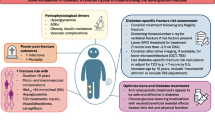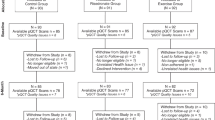Abstract
We present baseline bone densitometry from the Early Postmenopausal Interventional Cohort study (EPIC, sponsored by Merck, Sharp & Dohme) for the first time, in which 1609 women from England, Oregon, Hawaii and Denmark are participating to investigate the efficacy of daily oral alendronate to prevent early postmenopausal bone loss. We compared radiographic absorptiometry (RA) of the phalanges for bone mineral density (BMD) measurement with single-energy X-ray absorptiometry (SXA) of the distal forearm, and dual-energy X-ray absorptiometry (DXA) of the lumbar spine, proximal femur and distal forearm. In a random subgroup of 308 women, aged 45–60 years, on average 6 years since menopause (YSM), bone densitometry was measured once at baseline by RA of the phalanges besides the mandatory measurements by DXA. Bone densitometry was furthermore measured by SXA at the Danish site (89 women). Sixty-eight of the women had duplicate measurements performed within 1–3 weeks to evaluate the short-term precision error (CV%). One hundred and one healthy premenopausal women, aged 25–48 years, were recruited at the Danish and Hawaiian sites to establish a reference group. The precision error was 1.5% for RA of the phalanges and in the range 1.0–2.2% for SXA and DXA. BMD by RA correlated with BMD measured by SXA and DXA in the range 0.45<r<0.72 (p<0.001). In conclusion, bone densitometry by RA of the phalanges is highly correlated with bone densitometry by SXA and DXA. RA of the phalanges has a short-term precision error comparable to that of SXA and DXA.
Similar content being viewed by others
References
Mazess RB. On aging bone loss. Clin Orthop 1982;165:239–52
Hayse WC, Gerhard TN. Biomechanics of bone: applications for assessment of bone strength. In: Peck WA, editor. Bone and mineral research 3. Amsterdam: Elsevier, 1985:259–94.
Melton LJ III, Chao EYS, Lane J. Biomechanical aspects of fractures. In: Riggs L, Melton LJ III, editors. Osteoporosis: etiology, diagnosis, and management. New York: Raven Press, 1988:111–31.
Ross PD, Davis JW, Vogel JM, Wasnich R. A critical review of bone mass and the risk of fractures in osteoporosis. Calcif Tissue Int 1990;46:149–61.
Melton LJ III, Atkinson J, O'Fallon WM, Wahner HW, Riggs BL. Long-term fracture prediction by bone mineral assessed at different skeletal sites. J Bone Miner Res 1993;8:1227–33.
Wahner HW, Dunn WL, Riggs BL. Assessment of bone mineral: I. J Nucl Med 1984;25:1134–41.
Conference report. Consensus development conference: diagnosis, prophylaxis, and treatment of osteoporosis. Am J Med 1993;94:646–50.
Borg J, Møllgaard A, Riis BJ, A small, easy operational equipment for bone mass measurement: single x-ray absorptiometry (SXA). Performance characteristics. Osteoporosis Int 1995;5:377–81.
Kelly TL, Crane G, Baran DT. Single X-ray absorptiometry of the forearm: precision, correlation and reference data. Calcif Tissue Int 1994;54:212–8.
Genant HK, Block JE, Steiger P, Glüer CC, Ettinger B, Harris ST. Appropriate use of bone densitometry. Radiology 1989;170:817–22.
Genant HK, Cann CE, Ettinger B, Gordon GS. Quantitative computed tomography of vertebral spongiosa: a sensitive method for detecting early bone loss after oophorectomy. Ann Intern Med 1982;97:689–705.
Genant HK, Engelke K, Fuerst T, Gluer CC et al. Non invasive assessment of bone mineral and structure: state of the art. J Bone Miner Res 1996;11:707–30.
Mautalen C, Vega E, Gonzalez D, Carrilero P, Otano A, Silberman F. Ultrasound and dual x-ray absorptiometry densitometry in women with hip fracture. Calcif Tissue Int 1995;57:165–8.
Porter RW, Miller CG, Grainger D, Palmer SB. Prediction of hip fracture in elderly women: a prospective study. BMJ 1990;301:638–41.
Barnett E, Nordin BEC. The radiological diagnosis of osteoporosis: new approach. Clin Radiol 1960;11:166–74.
Colbert C, Garrett C. Photodensitometry of bone roentgenograms with an on-line computer. Clin Orthop Rel Res 1969;65:39–45.
Trouerbach WT, Birkenhager JC, Schmitz PIM, van Hemert AM, van Saase JLCM, Collette HJA, Zwamborn AW. A cross-sectional study of age-related loss of mineral content of phalangeal bone in men and women. Skeletal Radiol 1988;17:338–43.
Matsumoto C, Kushida K, Yamazaki K, Imose, Inoue T. Metacarpal bone mass in normal and osteoporotic Japanese women using computed x-ray densitometry. Calcif Tissue Int 1994;55:324–9.
Cosman F, Herrington B, Lindsay R. Radiographic absorptiometry: a simple method for determination of bone mass. Osteoporosis Int 1991;2:34–8.
Kleerekoper M, Nelson DA, Flynn MJ, Pawluszka AS, Jacobsen G, Peterson EL. Comparison of radiographic absorptiometry with dual energy x-ray absorptiometry and quantitative computed tomography in normal older White and Black women. J Bone Miner Res 1994;9:1745–9.
Mussolino M, Looker A, Madans J, Edelstein D, Walker R, Lydick E, Epstein R. Phalangeal bone density and hip fracture risk [abstract]. J Bone Miner Res 1995;10 (Suppl 1):S360.
Yang SO, Hagiwara S, Engelke K, Dhillon MS, Guglielmi G, Bendavid EJ, Soejima O, Nelson DL, Genant HK. Radiographic absorptiometry for bone mineral measurement of the phalanges: precision and accuracy study. Radiology 1994;192:857–9.
Hologic QDR-2000 operator's manual and user's guide. Hologic system software version 7.10.
Glüer CC, Blake G, Lu Y, Blunt BA, Jergas M, Genant HK. Accurate assessment of precision errors: how to measure the reproducibility of bone densitometry techniques. Osteoporosis Int 1995;5:262–70.
Riggs BL, Wahner HW, Seeman E, Offord KP, Dunn WL, Mazess RB, Johnson KA, Melton LJ III. Changes in bone mineral density of the proximal femur and spine with aging: differences between the postmenopausal and senile osteoporosis syndromes. J Clin Invest 1982;70:716–23.
Cummings SR. Are patients with hip fractures more osteoporo-tic? Review of evidence. Am J Med 1985;78:487–94.
Mazess RB, Peppier WW, Chesney RX, Lange TA, Lindgren U, Smith E Jr. Do bone measurements on the radius indicate skeleton status? Concise communication. J Nucl Med 1984;25:281–8.
Seldon DW, Esser PD, Alderson PO. Comparison of bone density measurements from different skeletal sites. J Nucl Med 1988;29:186–73.
Pocock NA, Eisman JA, Yeates MG, Sambrook PN, Eberl S, Wren BG. Limitations of forearm bone densitometry as an index of vertebral or femoral neck osteopenia. J Bone Miner Res 1986;1:369–75.
Hansen MA, Riis BJ, Overgaard K, Hassager C, Christiansen C. Bone mass measured by photon absorptiometry: comparison of forearm, heel, and spine. Scand J Clin Lab Invest 1990;50:517–23.
Nilas L, Nørgaard H, Pødenphant J, Gotfredsen A, Christiansen C. Bone composition in the distal forearm. Scand J Clin Lab Invest 1987;47:41–6.
Nottestad S, Baumel J, Kimmel D, Recker R, Heaney R. The porportion of trabecular bone in human vertebrae. J Bone Miner Res 1987;2:221–9.
Gärdsell P, Johnell O, Nilsson BE, Gullberg B. Predicting fragility fractures in women by forearm bone densitometry: a follow-up study. Calcif Tissue Int 1993;52:348–53.
Overgaard K, Hansen MA, Riis BJ, Christiansen C. Discriminatory ability of bone mass measurement (SPA and DEXA) for fractures in elderly postmenopausal women. Calcif Tissue Int 1992;50:30–5.
Cummings SR, Black DM, Nevitt MC, Browner W, Cauley J, Ensrud K, Genant HK, Palmero L, Scott J, Vogt TM. Bone density at various sites for prediction of hip fractures. Lancet 1993;314:72–5.
Adams J, Benevolenskaya L, Cannata J, Dodenhof C, Felsenberg D, Nijs J, O'Neil T, Reeve J, Reid D, Scheidt-Nave C, Weber K. Bone density varies between eleven populations participating in the European prospective osteoporosis study (EPOS) [abstract]. J Bone Miner Res 1994;9(Suppl 1):S129.
Author information
Authors and Affiliations
Consortia
Rights and permissions
About this article
Cite this article
Ravn, P., Overgaard, K., Huang, C. et al. Comparison of bone densitometry of the phalanges, distal forearm and axial skeleton in early postmenopausal women participating in the EPIC study. Osteoporosis Int 6, 308–313 (1996). https://doi.org/10.1007/BF01623390
Received:
Accepted:
Issue Date:
DOI: https://doi.org/10.1007/BF01623390




